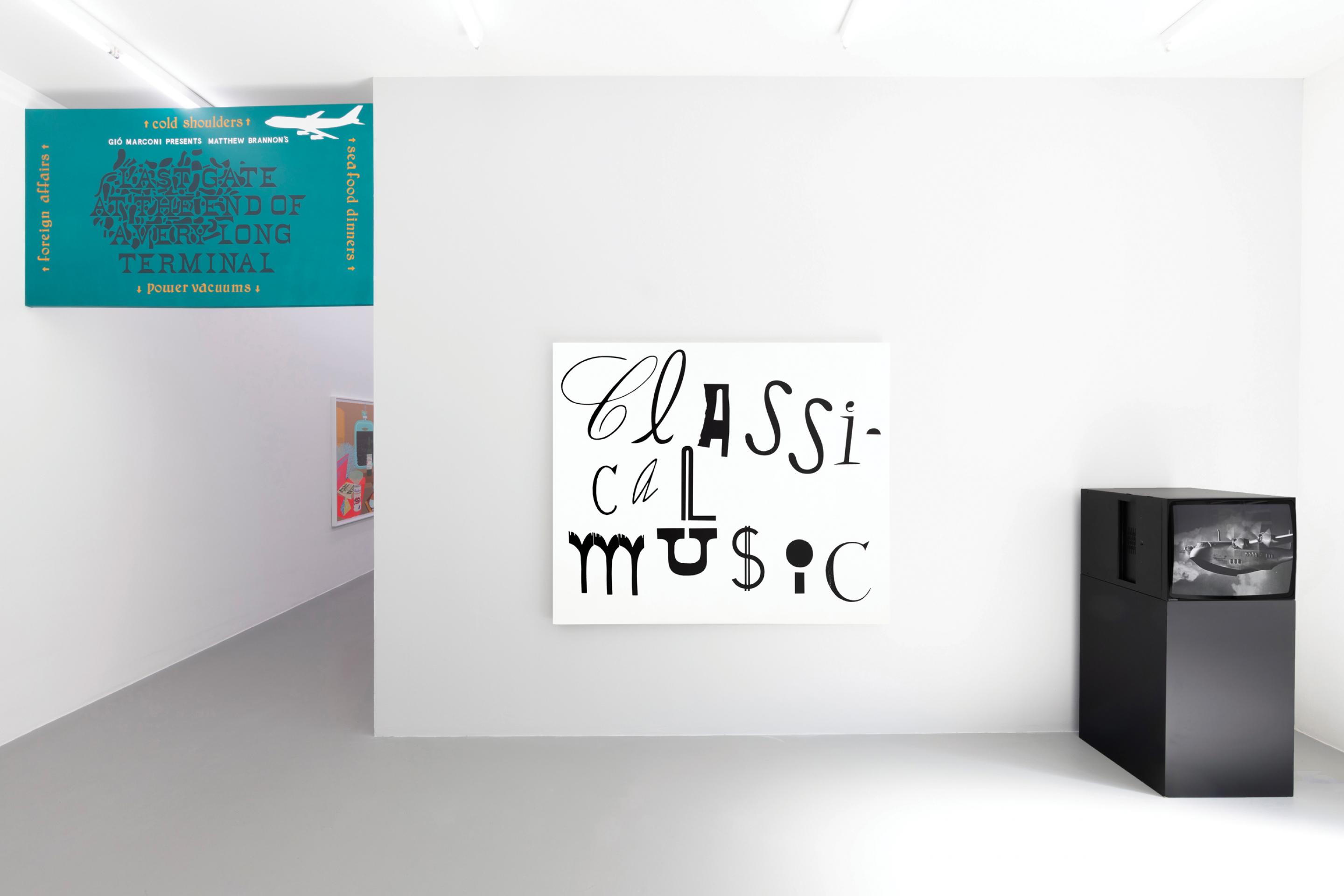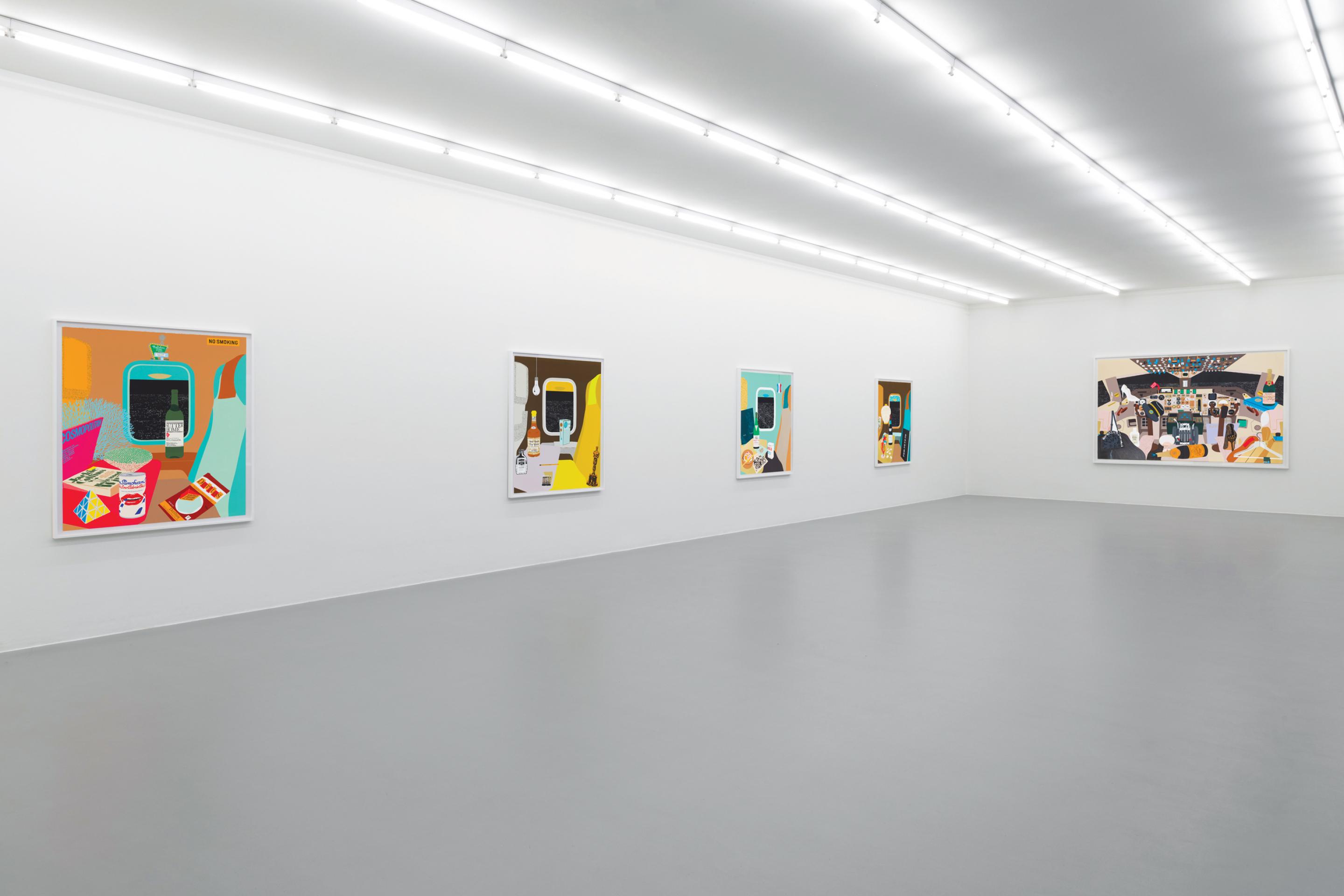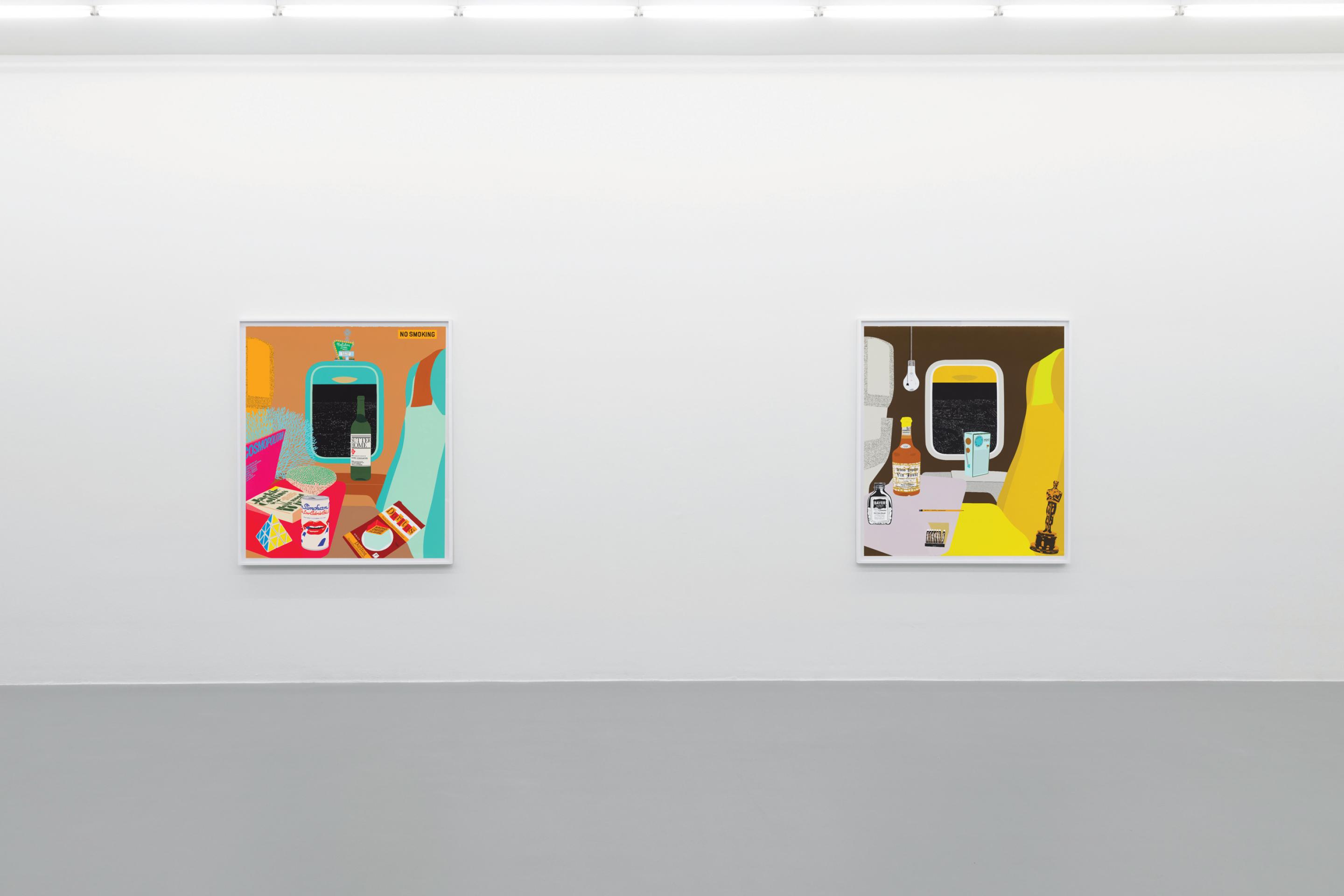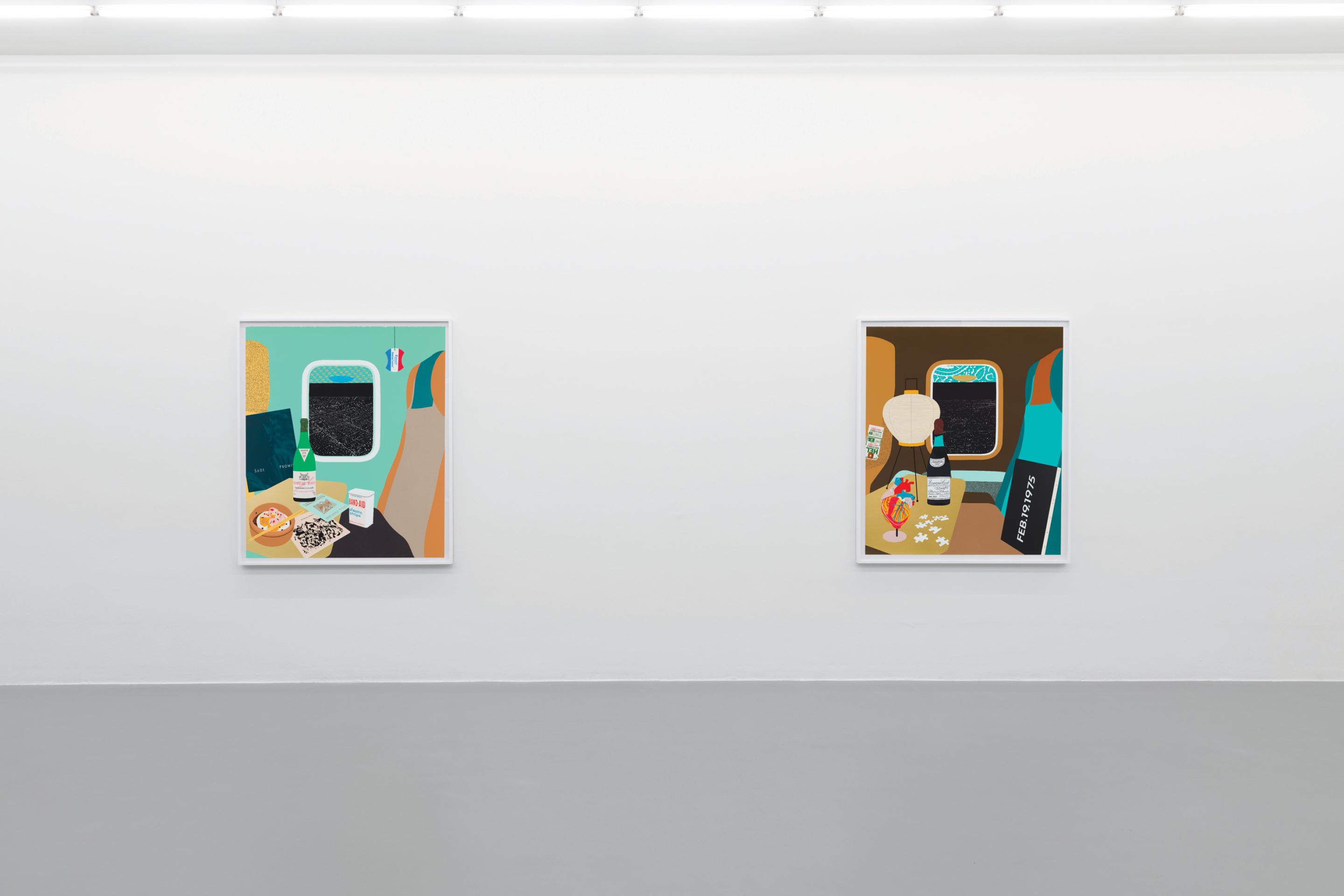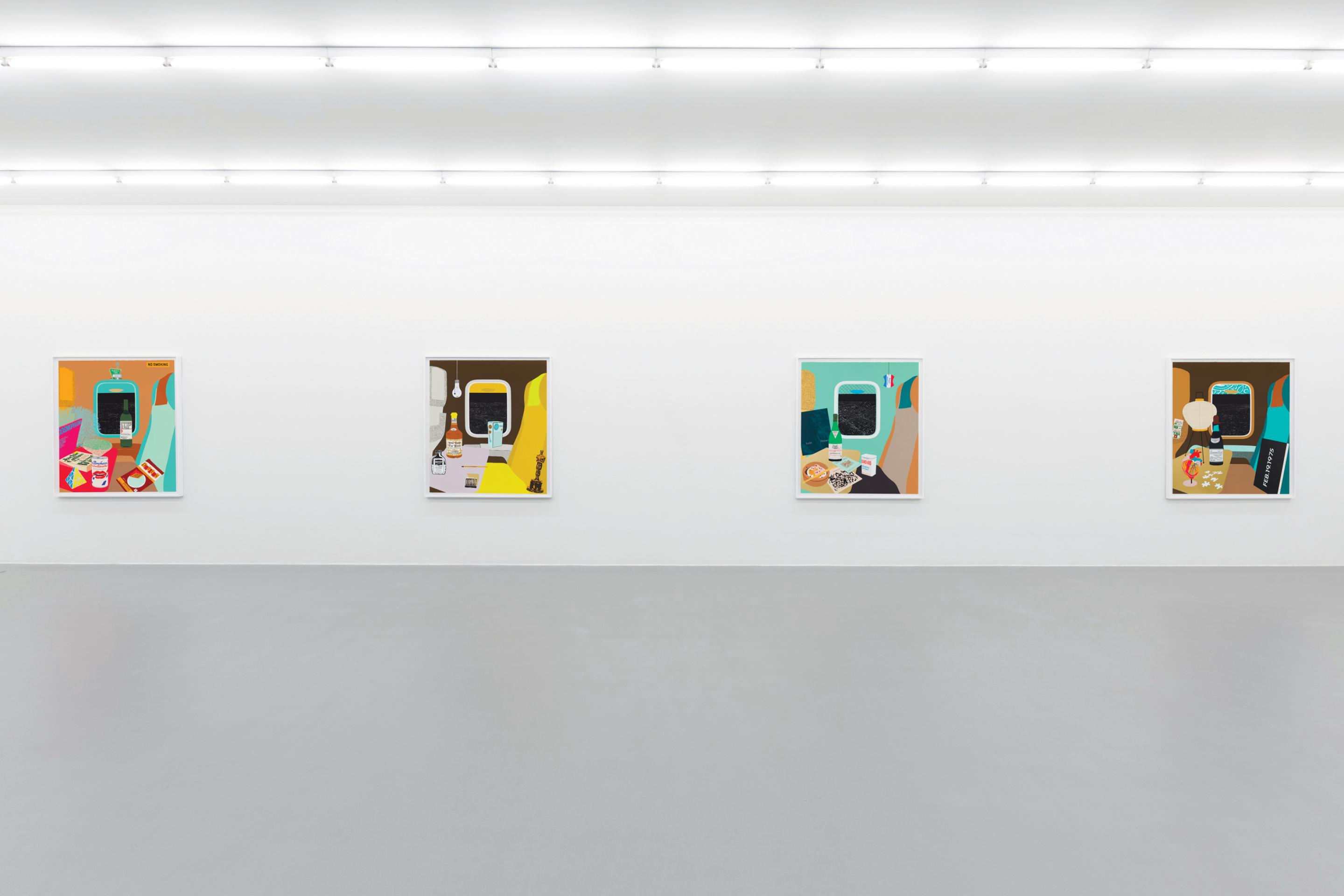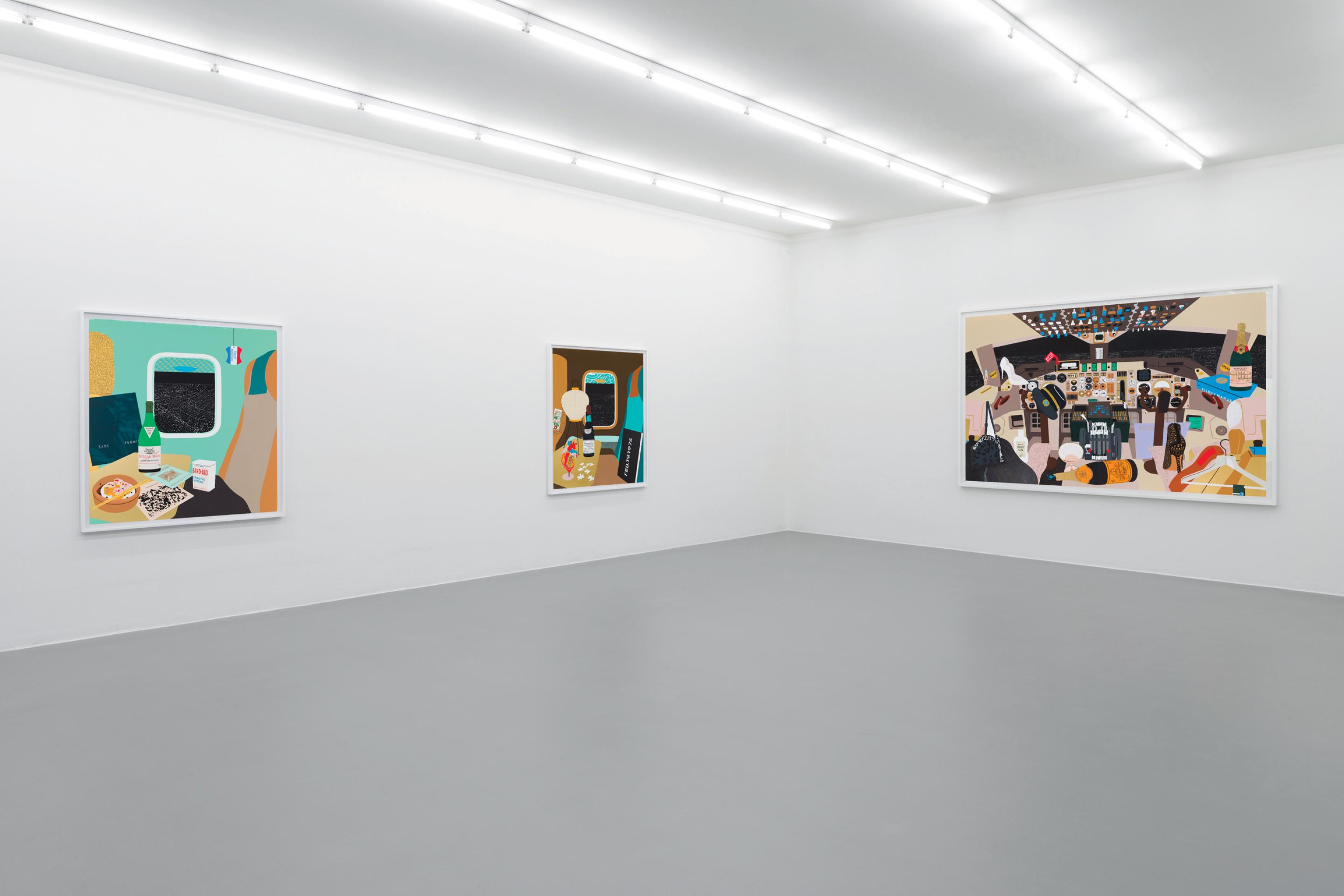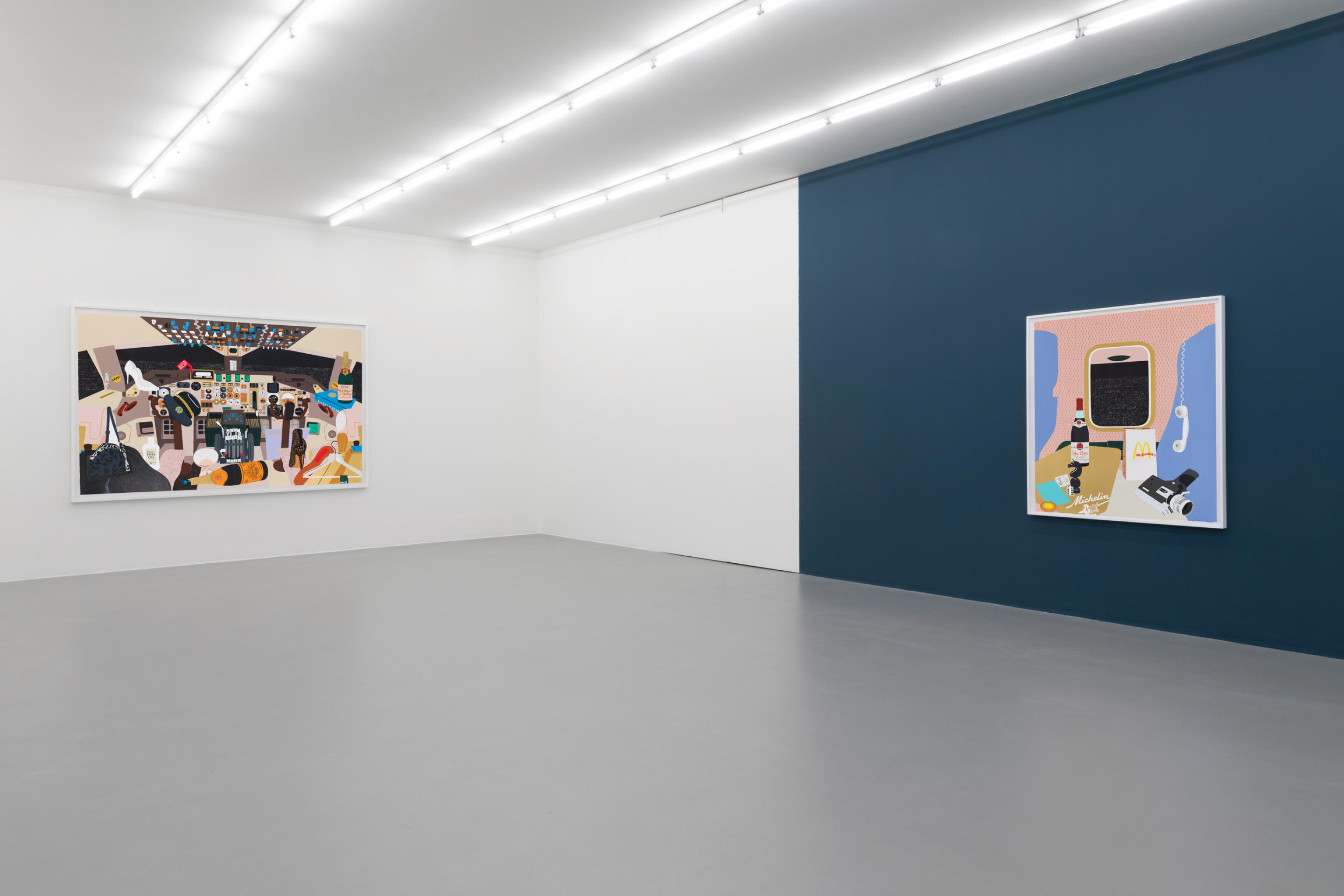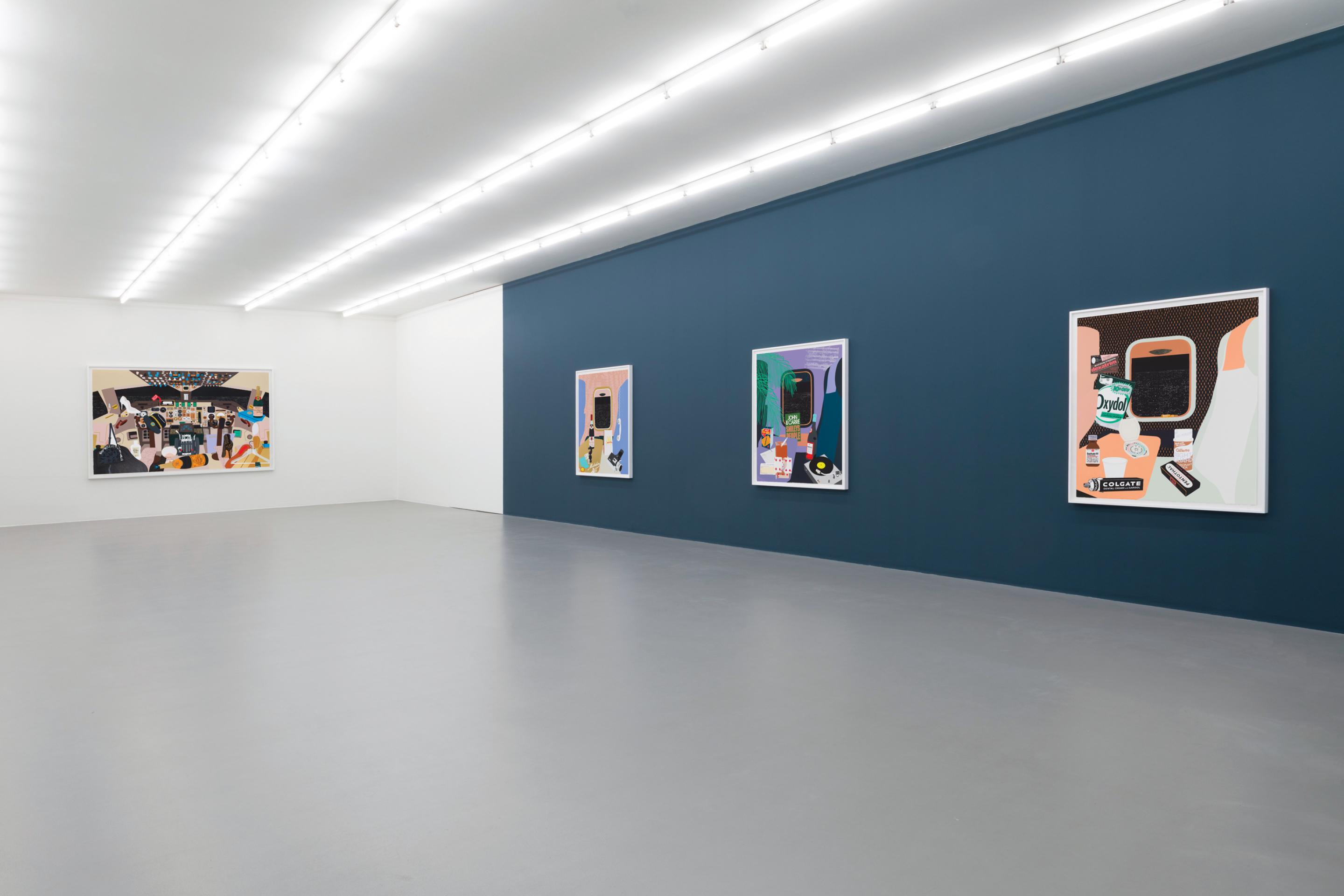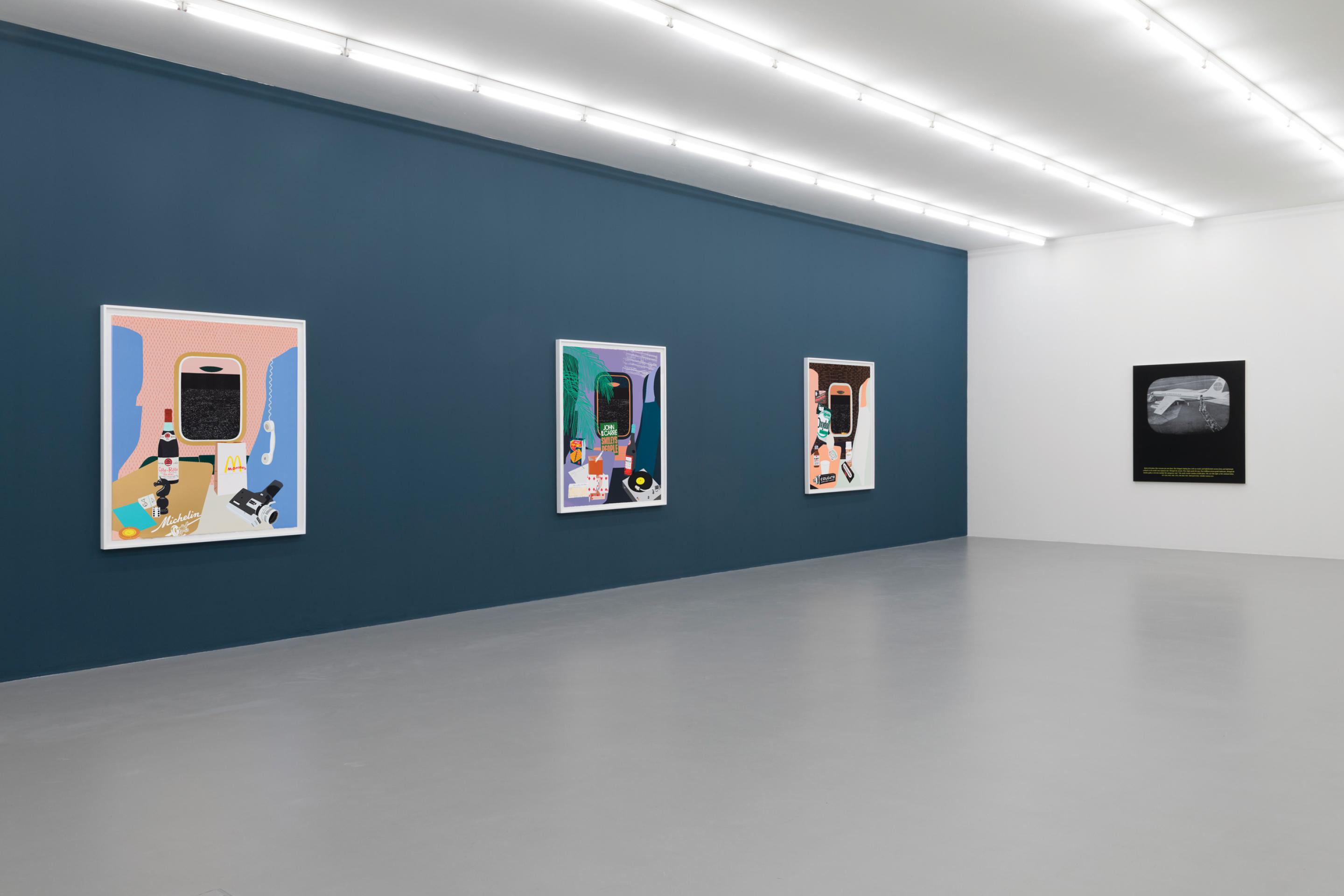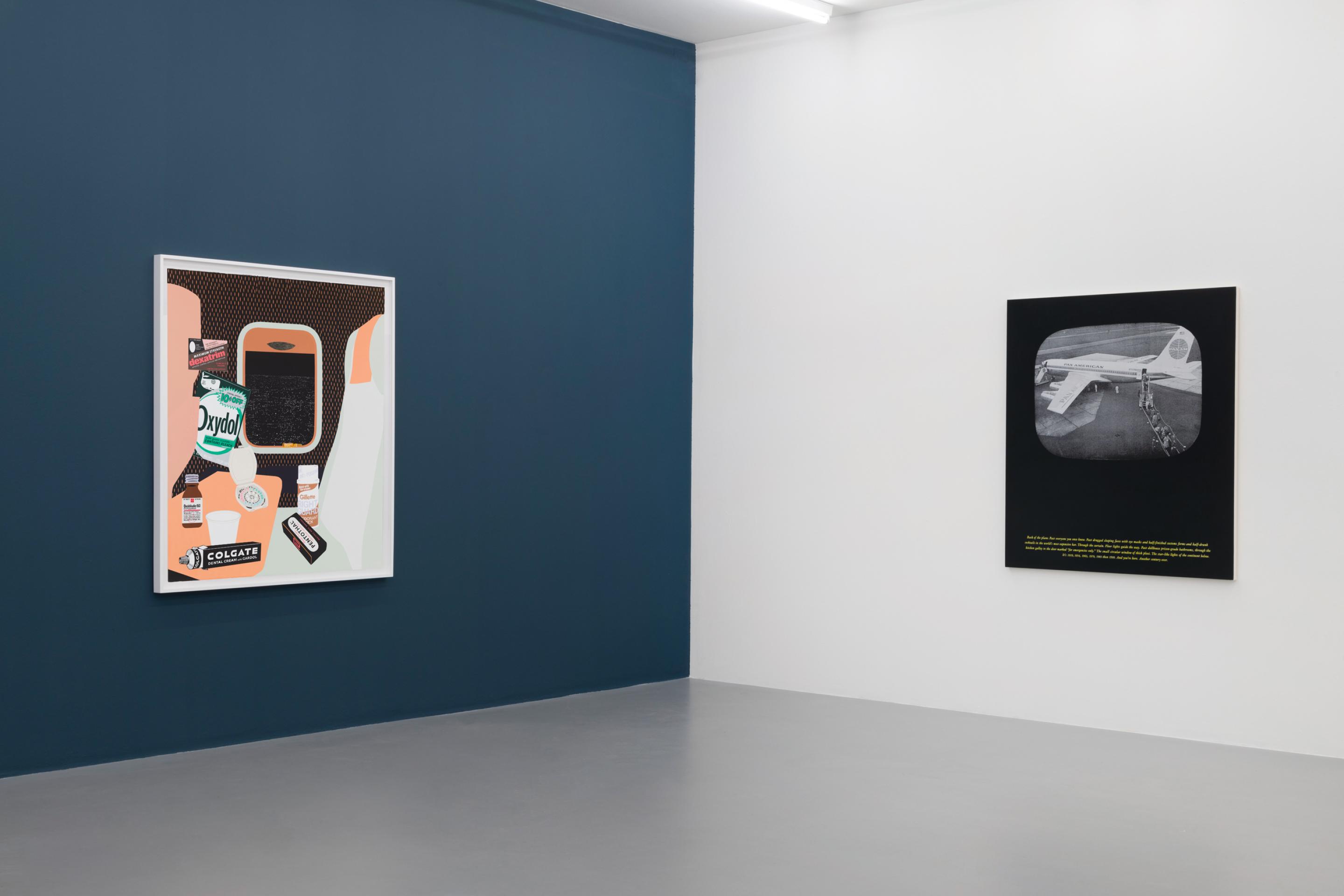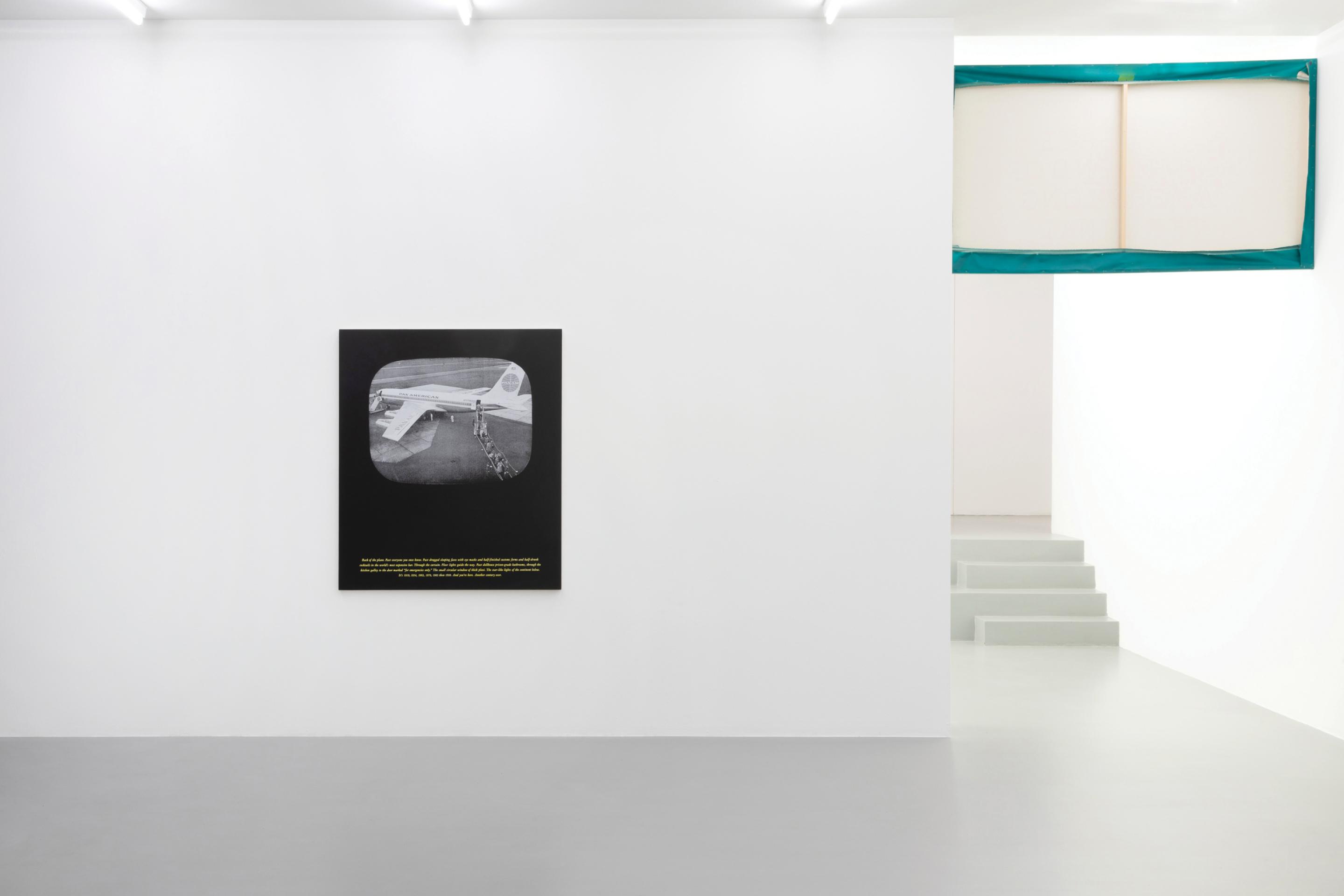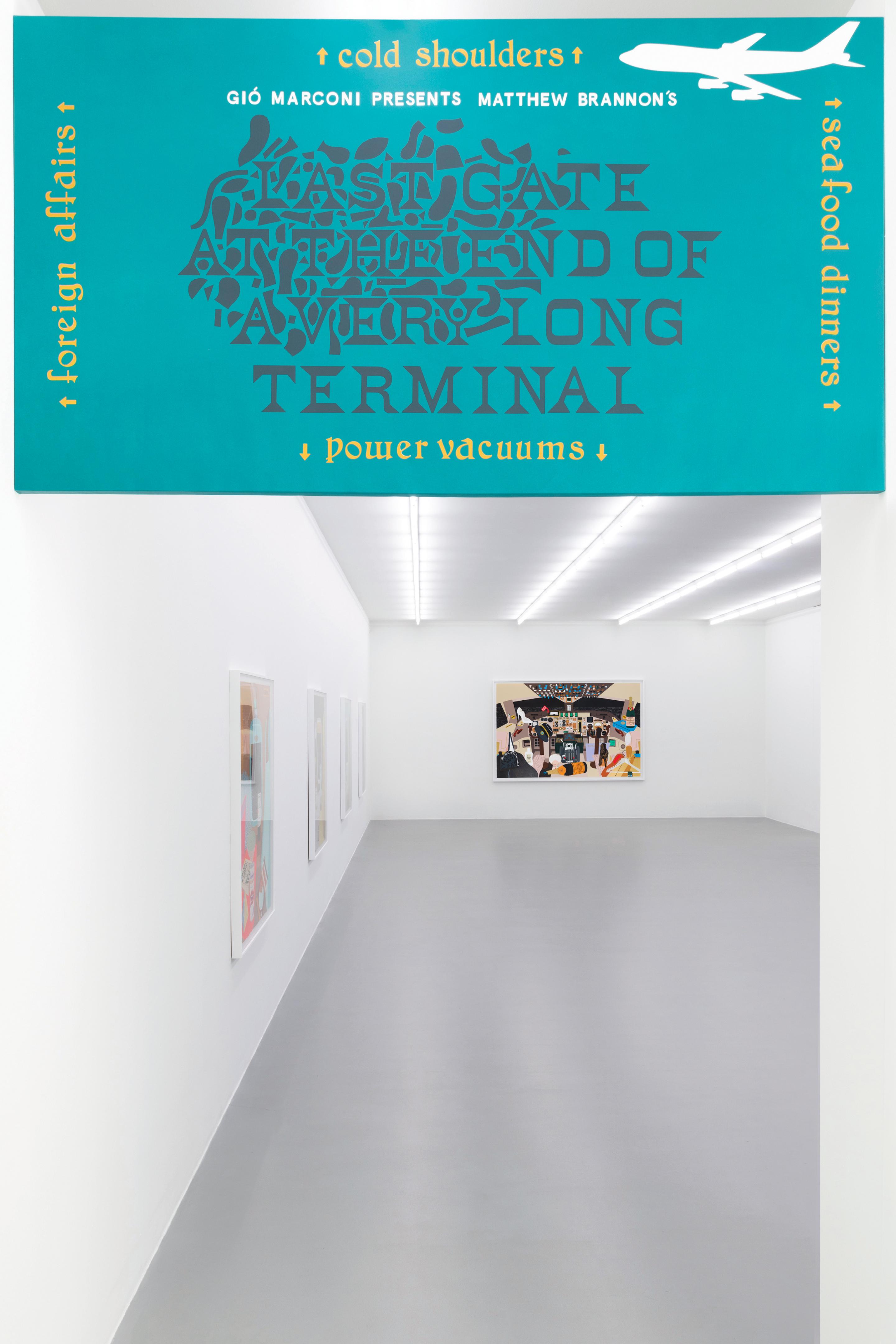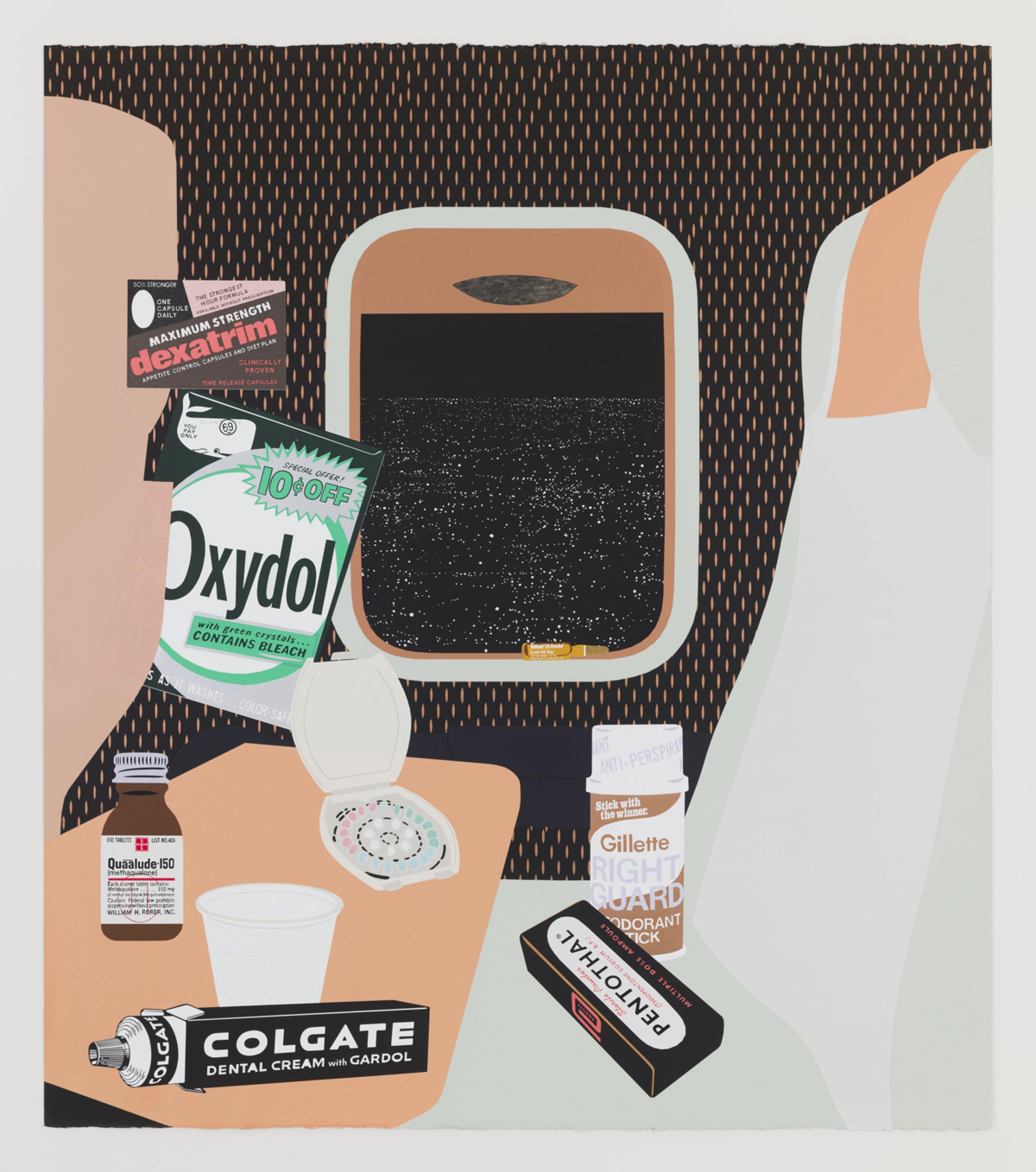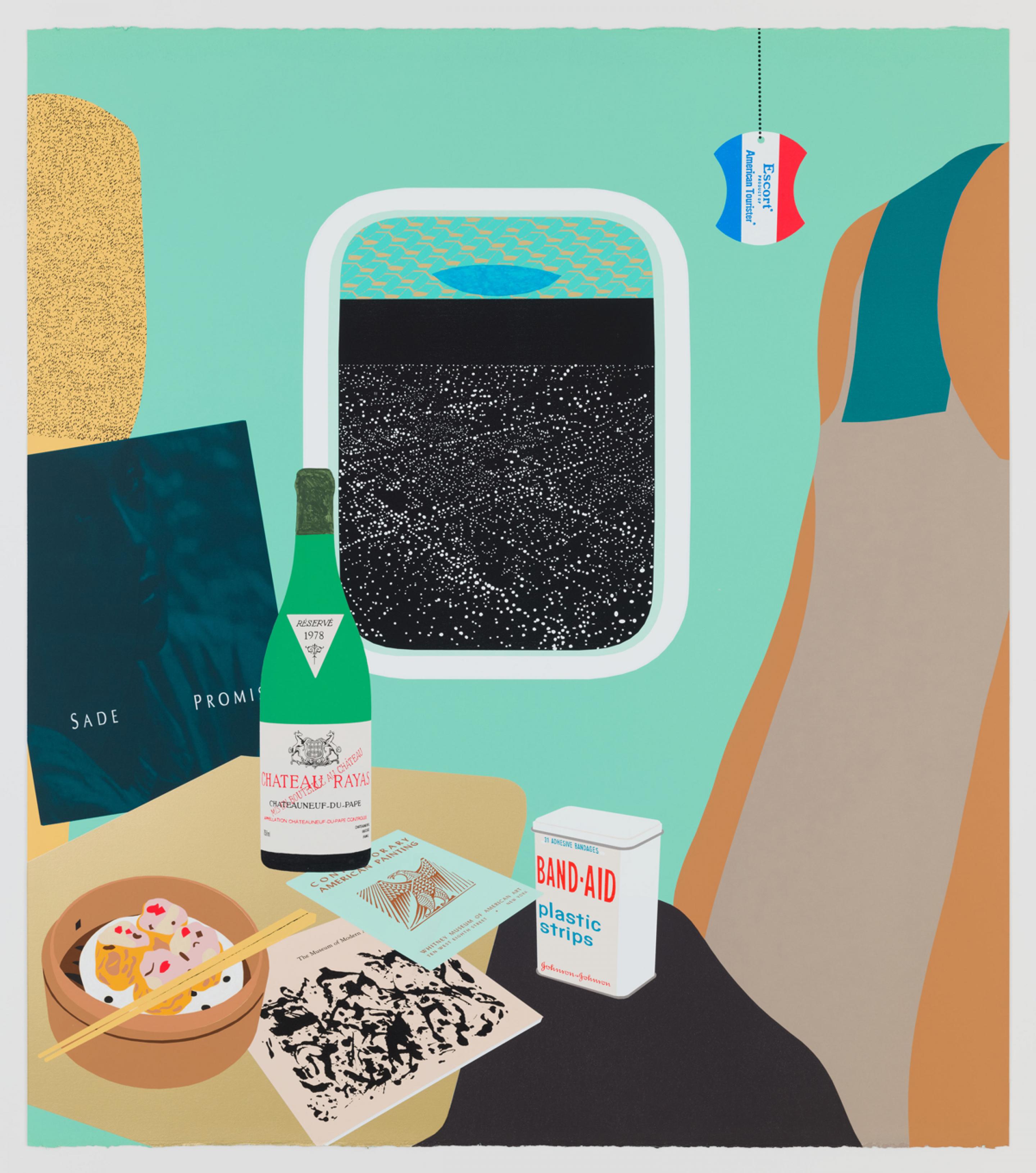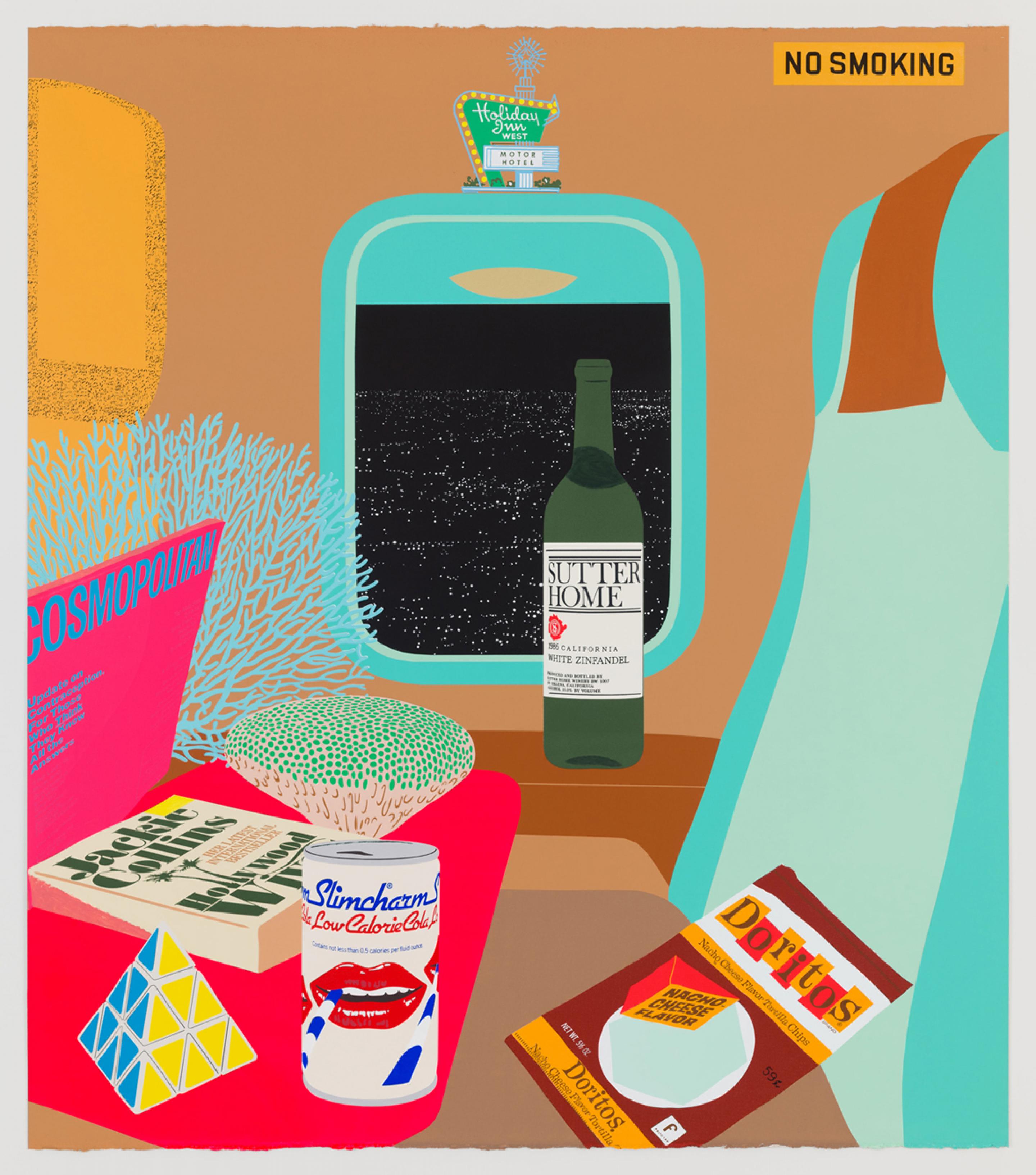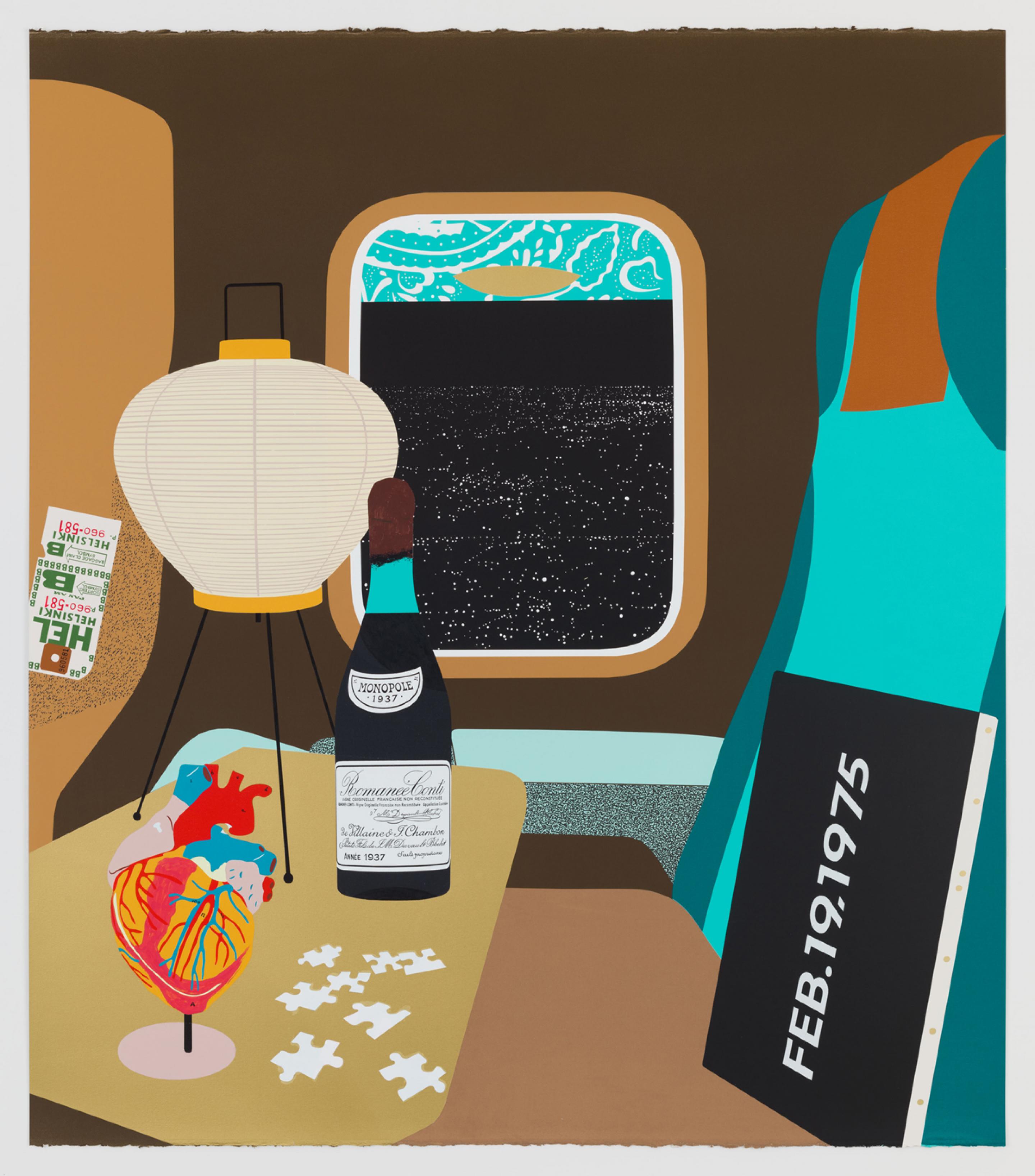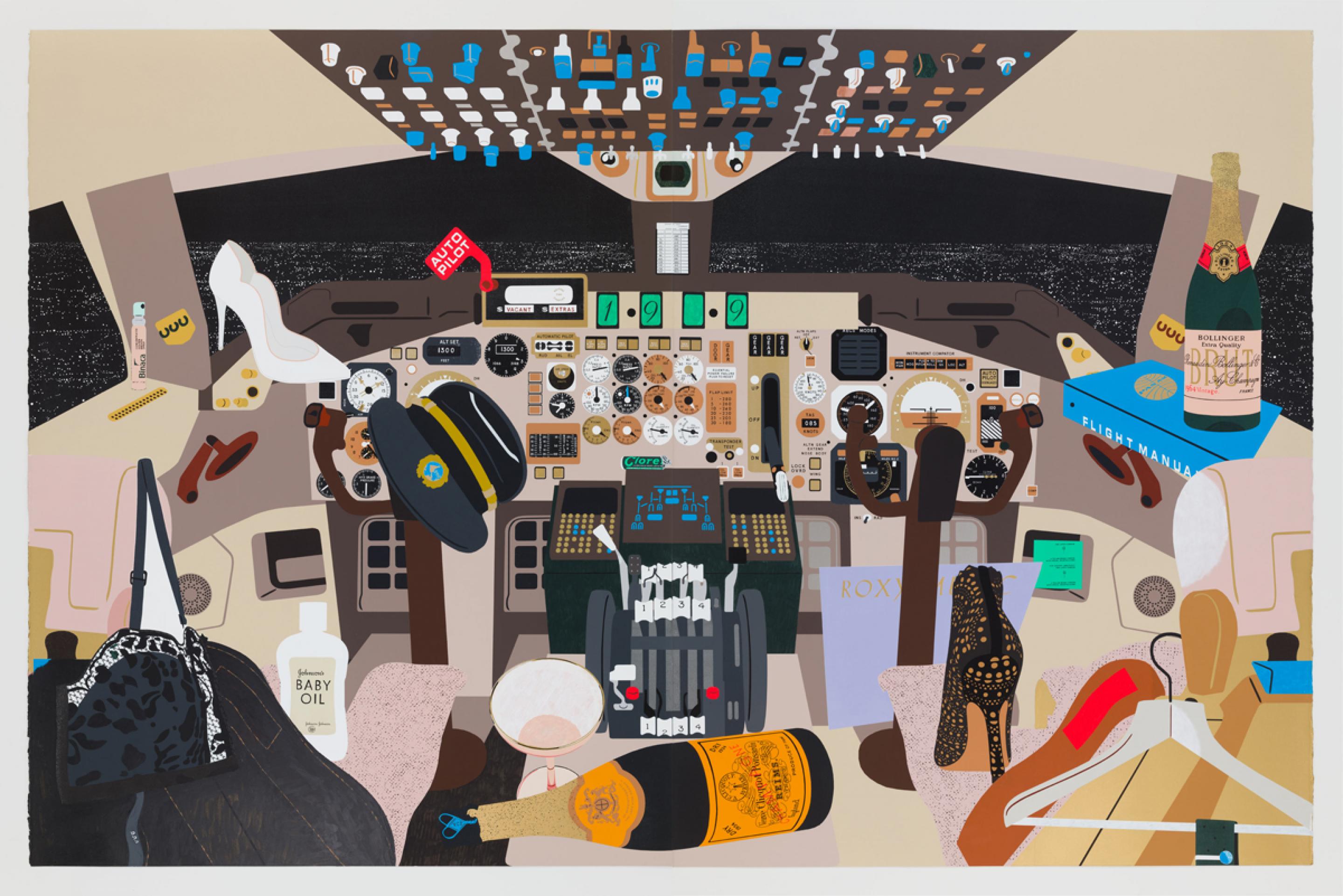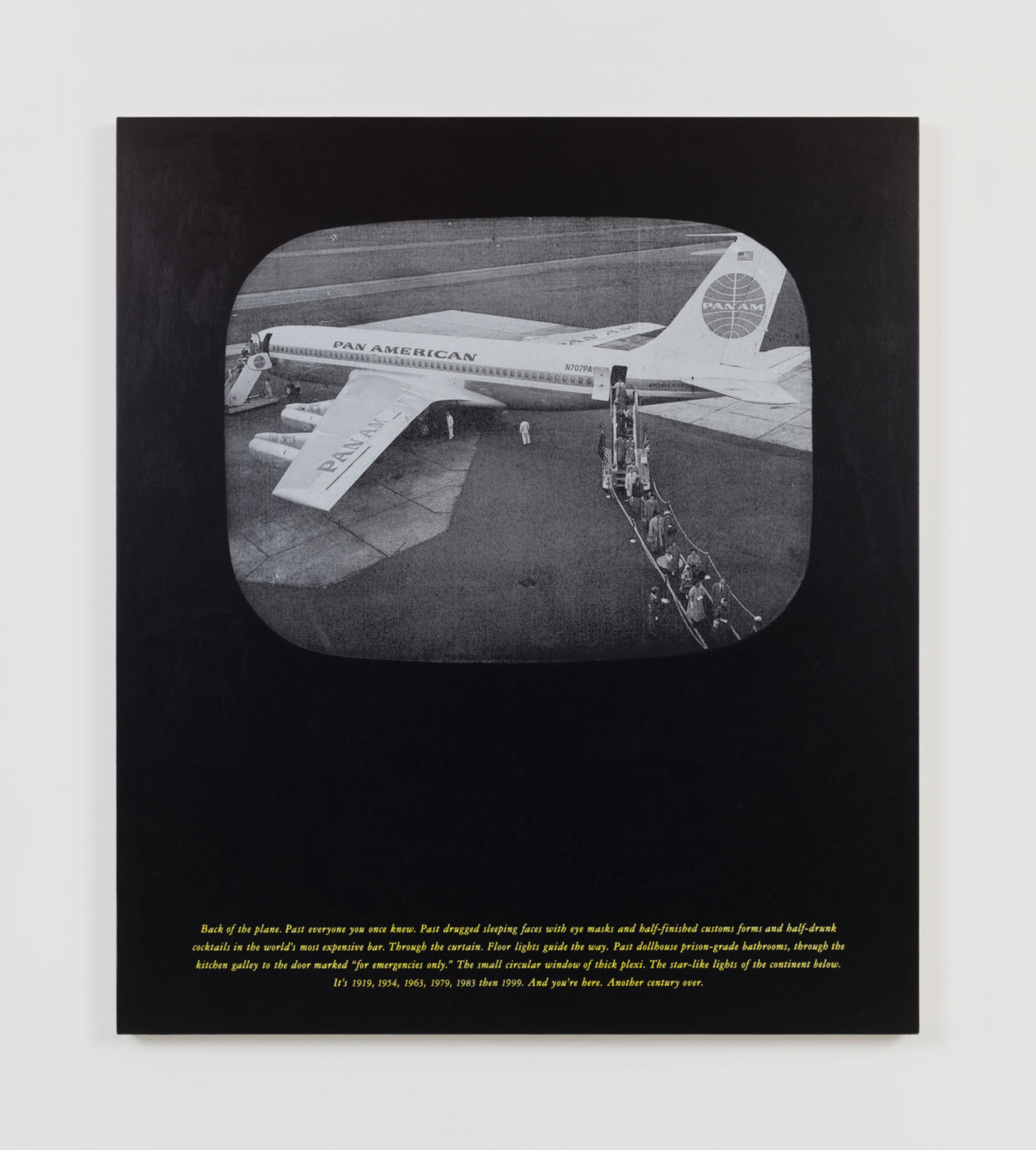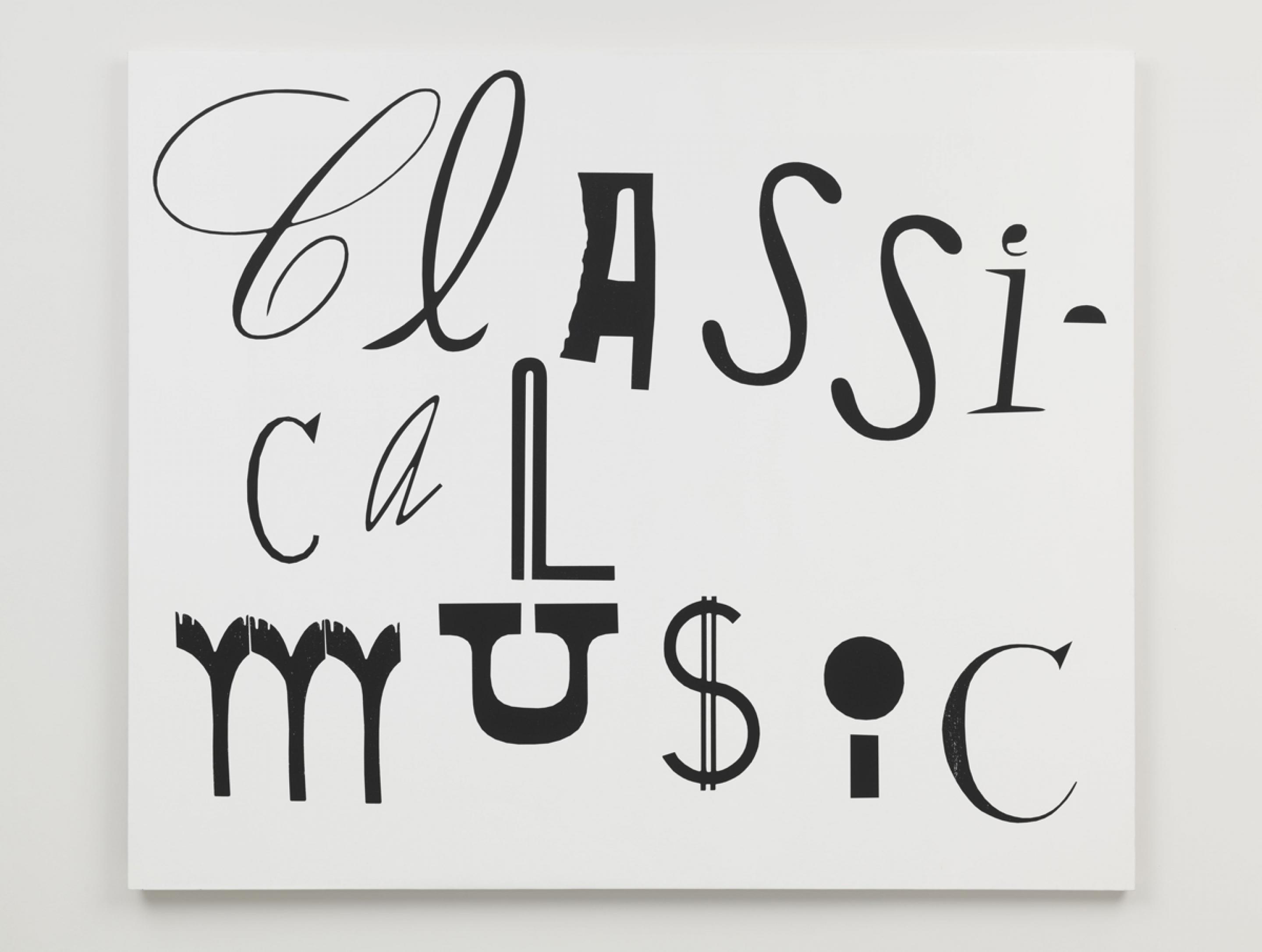MatthewBRANNON
Cold Shoulders / Foreign Affairs / Seafood Dinners / Pregnant Décor / Power Vacuums / and The Last Gate at the End of a Long Terminal
Gió Marconi, Milan
08.04.–03.06.2021
Cold Shoulders / Foreign Affairs / Seafood Dinners / Pregnant Décor / Power Vacuums / and The Last Gate at the End of a Long Terminal
Gió Marconi, Milan
08.04.–03.06.2021
IT
Matthew Brannon
Cold Shoulders / Foreign Affairs / Seafood Dinners / Pregnant Décor / Power Vacuums / and The Last Gate at the End of a Long Terminal
8 Aprile – 3 Giugno 2021
martedì - sabato; 11-19
Gió Marconi ha il piacere di annunciare "Cold Shoulders / Foreign Affairs / Seafood Dinners / Power Vacuums / and The Last Gate at the End of a Very Long Terminal", la terza personale di Matthew Brannon con la galleria.
Ho realizzato questa mostra durante l'anno surreale che è stato il 2020. Ho immaginato un aereo sospeso a mezz’aria sopra una città in un qualche momento durante il secolo scorso. Leggero come una piuma, pesante come una balena. Ogni opera mostra il sedile di un passeggero invisibile. È il set di una produzione teatrale dopo che lo spettacolo è finito e le telecamere sono spente. È quel momento in cui ti svegli appena prima di ricordarti tutto quello che devi fare. È il centro di un libro che ho scritto molto tempo fa. È uno spazio in cui puoi entrare. Il mondo fluttuante. - Matthew Brannon, New York City, marzo 2021
Eccolo. In mezzo all'oceano. Sterile come la luna. Giù per miglia sotto l'acqua fredda e pesante. Dove vivono pochi pesci e ci sono meno piante che in un deserto. Solo rocce molto vecchie grandi come montagne. Ci vuole un grande dispiego di forze per spingere l’aereo verso il basso e c’è bisogno di luci come quelle che si usano nei grandi stadi, eppure tutto quello che vedi è nero. Come guidare in un temporale in un incubo nello spazio siderale. E poi è lì. Come un serpente di proporzioni preistoriche. Il cobra più grande del mondo. Capace di divorare persone a bocconi. Scintillante ma morto. Un’enorme prolunga che attraversa i continenti. È il cavo di rete. E tu fai quello che devi. Quello che hai sempre sognato da quando è iniziato. Un modo per salvare il mondo. Un modo per fermare tutta la follia, la distorsione e l'impossibilità. E quando le enormi tenaglie del velivolo iniziano ad incidere l’esterno, è come se sentissi le urla di tutte quelle case piene di tutti quei dispositivi acquistati online e totalmente dipendenti da questo stesso sangue che ora stai interrompendo. Ogni gigantesco taglio nel cavo cancella miliardi di e-mail, messaggi di testo, download, caricamenti e streaming ed evaporano persino e-mail cancellate da tempo. E poi, come il suono di un ghiacciaio che si spezza o di un crack in un bicchiere di vino in una stanza vuota, è finita. E la tensione tira entrambe le estremità del cavo a migliaia di miglia di distanza. Sarà più facile ricostruirne uno che ricollegarle. E tutti avranno bisogno di nuove password. E passerà una generazione prima che funzioni di nuovo.
Matthew Brannon è artista e scrittore, ma è forse ancor più conosciuto per il suo approccio alle tecniche di stampa. Lavora principalmente con la serigrafia e la tipografia, pratiche che invitano alla giustapposizione giocosa di immagini e testo. La sensibilità letteraria, l'arguzia, l'uso giocoso del linguaggio e il fascino per la psicoanalisi sono stati a lungo gli elementi chiave dell'opera di Brannon. Da scultura e pittura a installazione e video: l'artista tratta ogni mezzo espressivo con la massima precisione e con uno straordinario senso del dettaglio.
Negli ultimi sei anni Brannon ha esplorato principalmente le ramificazioni della guerra del Vietnam. Il risultato è Concerning Vietnam, una serie di oltre 75 stampe uniche.
La mostra di Brannon in galleria riguarda il concetto di viaggio e il passare del tempo.
L'idea di viaggiare liberamente è diventata quasi un'ossessione da quando il mondo si è fermato all'inizio del 2020 e le chiusure globali hanno tenuto le persone a casa. C'è un desiderio sempre più urgente di spostarsi e viaggiare di nuovo. Con il suo stile unico, che ricorda le riviste di lifestyle e le pubblicità della metà del XX secolo, Brannon cattura questo particolare momento attuale, pieno di desiderio e nostalgia, e lo traduce in immagini densamente colorate e ricche di dettagli.
La grande tela in bianco e nero Classical Music, all’entrata della galleria, prepara il palco per il resto dello spettacolo: si viaggerà con classe e stile. Last Gate at the end of a very long Terminal che si legge sull’insegna sopra l'ingresso alla mostra, serve sia come indicazione che come descrizione arguta dello status quo.
In sala sono in mostra gli interni degli aerei dai colori vivaci: un’opera di grandi dimensioni sulla parete di fondo mostra la cabina di pilotaggio dell'aereo, mentre opere di medie dimensioni su ciascuna delle pareti laterali raffigurano diverse file di sedili.
Ognuna di queste composizioni include un sedile, un tavolino e un finestrino con vista dall’alto su una città notturna. Le opere, tutte serigrafie uniche, sono nature morte ricche di oggetti e dettagli accuratamente ricercati: bottiglie di vino costose si scontrano con sacchetti di McDonald's, deodoranti e dentifrici; mentre pedine degli scacchi, carte da gioco, libri e riviste parlano di abitudini di viaggio precedenti. Strani oggetti come un modello anatomico del cuore, una confezione di candeggina o un pezzo di prosciutto, danno allo spettatore un'idea dei gusti e della personalità del viaggiatore, così come le varie scelte letterarie da Pasolini ai romanzi gialli e a quelli rosa. Titoli narrativi ma comunque enigmatici come Wet Kisses, Dry Ideas; Mouth-to-Mouth; Double Negative o War Correspondent contribuiscono all'aspetto dello story-telling della pratica di Brannon.
Ogni pezzo da solo non è solo un'opera d'arte bidimensionale, ma evoca un racconto breve con un titolo stravagante e una trama accuratamente delineata. Tutte le opere combinate sembrano capitoli diversi di un diario di viaggio. L'abilità di Matthew Brannon nel tradurre le opere d'arte in storie ricche di dettagli è visibile all’interno della mostra. I confini tra immagine e narrazione sono sottili.
Matthew Brannon (n. 1971, St. Maries, Idaho), vive e lavora a New York.
Le sue opere sono presenti nelle collezioni permanenti di numerosi musei: the Museum of Modern Art, New York; Whitney Museum of American Art, New York; Los Angeles County Museum of Art, Los Angeles; Hammer Museum, Los Angeles; Denver Art Museum, Denver; Albright-Knox Art Gallery, Buffalo; DESTE Foundation for Contemporary Art, Atene; Museo Madre, Napoli.
Tra le più recenti mostre personali: Museo Marino Marini, Firenze (2013); Portikus, Francoforte (2012); Museum M, Leuven (2010); Whitney Museum of American Art at Altria, New York (2007); Art Gallery of York University, Toronto (2007).
Tra le più recenti mostre collettive: Becoming American, San Juan Island National Historic Park, Friday Harbor, Washington (2018); Multiple Modernisms, Chrysler Museum of Art, Norfolk (2017); True Faith, Manchester Art Gallery, Manchester (2017); Trapping Lions in the Scottish Highlands, Aspen Art Museum, Aspen (2013); Brannon, Büttner, Kierulf, Kierulf, Kilpper, Bergen Kunsthall, Bergen (2012).
Cold Shoulders / Foreign Affairs / Seafood Dinners / Pregnant Décor / Power Vacuums / and The Last Gate at the End of a Long Terminal
8 Aprile – 3 Giugno 2021
martedì - sabato; 11-19
Gió Marconi ha il piacere di annunciare "Cold Shoulders / Foreign Affairs / Seafood Dinners / Power Vacuums / and The Last Gate at the End of a Very Long Terminal", la terza personale di Matthew Brannon con la galleria.
Ho realizzato questa mostra durante l'anno surreale che è stato il 2020. Ho immaginato un aereo sospeso a mezz’aria sopra una città in un qualche momento durante il secolo scorso. Leggero come una piuma, pesante come una balena. Ogni opera mostra il sedile di un passeggero invisibile. È il set di una produzione teatrale dopo che lo spettacolo è finito e le telecamere sono spente. È quel momento in cui ti svegli appena prima di ricordarti tutto quello che devi fare. È il centro di un libro che ho scritto molto tempo fa. È uno spazio in cui puoi entrare. Il mondo fluttuante. - Matthew Brannon, New York City, marzo 2021
Eccolo. In mezzo all'oceano. Sterile come la luna. Giù per miglia sotto l'acqua fredda e pesante. Dove vivono pochi pesci e ci sono meno piante che in un deserto. Solo rocce molto vecchie grandi come montagne. Ci vuole un grande dispiego di forze per spingere l’aereo verso il basso e c’è bisogno di luci come quelle che si usano nei grandi stadi, eppure tutto quello che vedi è nero. Come guidare in un temporale in un incubo nello spazio siderale. E poi è lì. Come un serpente di proporzioni preistoriche. Il cobra più grande del mondo. Capace di divorare persone a bocconi. Scintillante ma morto. Un’enorme prolunga che attraversa i continenti. È il cavo di rete. E tu fai quello che devi. Quello che hai sempre sognato da quando è iniziato. Un modo per salvare il mondo. Un modo per fermare tutta la follia, la distorsione e l'impossibilità. E quando le enormi tenaglie del velivolo iniziano ad incidere l’esterno, è come se sentissi le urla di tutte quelle case piene di tutti quei dispositivi acquistati online e totalmente dipendenti da questo stesso sangue che ora stai interrompendo. Ogni gigantesco taglio nel cavo cancella miliardi di e-mail, messaggi di testo, download, caricamenti e streaming ed evaporano persino e-mail cancellate da tempo. E poi, come il suono di un ghiacciaio che si spezza o di un crack in un bicchiere di vino in una stanza vuota, è finita. E la tensione tira entrambe le estremità del cavo a migliaia di miglia di distanza. Sarà più facile ricostruirne uno che ricollegarle. E tutti avranno bisogno di nuove password. E passerà una generazione prima che funzioni di nuovo.
Matthew Brannon è artista e scrittore, ma è forse ancor più conosciuto per il suo approccio alle tecniche di stampa. Lavora principalmente con la serigrafia e la tipografia, pratiche che invitano alla giustapposizione giocosa di immagini e testo. La sensibilità letteraria, l'arguzia, l'uso giocoso del linguaggio e il fascino per la psicoanalisi sono stati a lungo gli elementi chiave dell'opera di Brannon. Da scultura e pittura a installazione e video: l'artista tratta ogni mezzo espressivo con la massima precisione e con uno straordinario senso del dettaglio.
Negli ultimi sei anni Brannon ha esplorato principalmente le ramificazioni della guerra del Vietnam. Il risultato è Concerning Vietnam, una serie di oltre 75 stampe uniche.
La mostra di Brannon in galleria riguarda il concetto di viaggio e il passare del tempo.
L'idea di viaggiare liberamente è diventata quasi un'ossessione da quando il mondo si è fermato all'inizio del 2020 e le chiusure globali hanno tenuto le persone a casa. C'è un desiderio sempre più urgente di spostarsi e viaggiare di nuovo. Con il suo stile unico, che ricorda le riviste di lifestyle e le pubblicità della metà del XX secolo, Brannon cattura questo particolare momento attuale, pieno di desiderio e nostalgia, e lo traduce in immagini densamente colorate e ricche di dettagli.
La grande tela in bianco e nero Classical Music, all’entrata della galleria, prepara il palco per il resto dello spettacolo: si viaggerà con classe e stile. Last Gate at the end of a very long Terminal che si legge sull’insegna sopra l'ingresso alla mostra, serve sia come indicazione che come descrizione arguta dello status quo.
In sala sono in mostra gli interni degli aerei dai colori vivaci: un’opera di grandi dimensioni sulla parete di fondo mostra la cabina di pilotaggio dell'aereo, mentre opere di medie dimensioni su ciascuna delle pareti laterali raffigurano diverse file di sedili.
Ognuna di queste composizioni include un sedile, un tavolino e un finestrino con vista dall’alto su una città notturna. Le opere, tutte serigrafie uniche, sono nature morte ricche di oggetti e dettagli accuratamente ricercati: bottiglie di vino costose si scontrano con sacchetti di McDonald's, deodoranti e dentifrici; mentre pedine degli scacchi, carte da gioco, libri e riviste parlano di abitudini di viaggio precedenti. Strani oggetti come un modello anatomico del cuore, una confezione di candeggina o un pezzo di prosciutto, danno allo spettatore un'idea dei gusti e della personalità del viaggiatore, così come le varie scelte letterarie da Pasolini ai romanzi gialli e a quelli rosa. Titoli narrativi ma comunque enigmatici come Wet Kisses, Dry Ideas; Mouth-to-Mouth; Double Negative o War Correspondent contribuiscono all'aspetto dello story-telling della pratica di Brannon.
Ogni pezzo da solo non è solo un'opera d'arte bidimensionale, ma evoca un racconto breve con un titolo stravagante e una trama accuratamente delineata. Tutte le opere combinate sembrano capitoli diversi di un diario di viaggio. L'abilità di Matthew Brannon nel tradurre le opere d'arte in storie ricche di dettagli è visibile all’interno della mostra. I confini tra immagine e narrazione sono sottili.
Matthew Brannon (n. 1971, St. Maries, Idaho), vive e lavora a New York.
Le sue opere sono presenti nelle collezioni permanenti di numerosi musei: the Museum of Modern Art, New York; Whitney Museum of American Art, New York; Los Angeles County Museum of Art, Los Angeles; Hammer Museum, Los Angeles; Denver Art Museum, Denver; Albright-Knox Art Gallery, Buffalo; DESTE Foundation for Contemporary Art, Atene; Museo Madre, Napoli.
Tra le più recenti mostre personali: Museo Marino Marini, Firenze (2013); Portikus, Francoforte (2012); Museum M, Leuven (2010); Whitney Museum of American Art at Altria, New York (2007); Art Gallery of York University, Toronto (2007).
Tra le più recenti mostre collettive: Becoming American, San Juan Island National Historic Park, Friday Harbor, Washington (2018); Multiple Modernisms, Chrysler Museum of Art, Norfolk (2017); True Faith, Manchester Art Gallery, Manchester (2017); Trapping Lions in the Scottish Highlands, Aspen Art Museum, Aspen (2013); Brannon, Büttner, Kierulf, Kierulf, Kilpper, Bergen Kunsthall, Bergen (2012).
EN
Matthew Brannon
Cold Shoulders / Foreign Affairs / Seafood Dinners / Pregnant Décor / Power Vacuums / and The Last Gate at the End of a Long Terminal
April 8 - June 3, 2021
From Tuesday to Saturday; 11am-7pm
Gió Marconi is pleased to announce “Cold Shoulders / Foreign Affairs / Seafood Dinners / Power Vacuums / and The Last Gate at the End of a Very Long Terminal”, Matthew Brannon’s third solo show with the gallery.
I made this exhibition during the surreal year that was 2020. I imagined a plane hovering in mid-air above a city sometime during the last century. Light as a feather, heavy as a whale. Each artwork shows the seat of an unseen passenger. It’s the set of a theatre production after the show is over and the cameras are off. It’s the moment upon waking before you remember all you have to do. It’s the center of a book I wrote long ago. It’s a space for you to enter. The floating world. – Matthew Brannon, New York City, March 2021
There it is. Out in the middle of the ocean. As barren as the moon. Down miles under cold and heavy water. Where few fish dwell and less plant life than a desert. Just very old rocks the size of mountains. It takes a great deal of force to propel the craft down and requires the sort of lights they use in massive stadiums and yet all you see is black. Like driving in a rainstorm in some outer-space nightmare. And then it’s there. Like a snake of prehistoric proportions. The world’s largest cobra. Able to devour mouthfuls of people. Glistening but dead. A huge extension cord running between the continents. It’s the internet cable. And you do what you have to. What you’ve been dreaming of since it began. A way to save the world. A way to stop all the madness and distortion and impossibility. And when the ship’s huge jaws of life begin to hack at the outside it’s as if you hear the screams of all those houses full of all those devices bought online and totally dependent on this very blood you’re now disrupting. Each giant slash into the cable cancels billions of emails and texts and downloads and uploads and streaming and even long deleted emails evaporate. And then like the sound of a glacier cracking or a crack in a wine glass in an empty room - it’s over. and the tension pulls both ends of the cable thousands of miles apart. It’ll be easier to rebuild one than to reattach these. And everyone will need new passwords. And a generation will pass before it’s back up.
Matthew Brannon is an artist and a writer but is probably best known for his expansive approach to printmaking. He primarily works in silk screen and letterpress, both of which invite the playful juxtapostition of image and text. Literary sensibility, wit, the playful use of language as well as the fascination with psychoanalysis have long been key elements of Brannon’s oeuvre. From sculpture and painting to installation and video – the artist treats each medium with the uttermost precision and with an extraordinary sense of detail.
For the last six years, Brannon has mostly been exploring the ramifications of the Vietnam War. The outcome is Concerning Vietnam, an ongoing series of more than 75 unique prints.
Brannon’s exhibition at the gallery is about the concept of travelling and the passage of time.
Ever since the world has come to a halt at the beginning of 2020 and worldwide lockdowns have kept people at home, the idea of traveling freely has become almost an obsession.
With his unique style, reminiscent of lifestyle magazines and advertisings from the mid-twentieth century, Brannon captures this particular current moment full of wanderlust, longing and nostalgia and translates it into densely coloured and detail-rich images.
The large black and white Classical Music canvas in the gallery’s anteroom sets the stage for the rest of the show: one is going to travel in class and style. Last Gate at the end of a very long Terminal reads the sign above the entrance to the exhibition, serving both as a writing on the wall as well as a witty description of the status quo.
Inside the space, vibrantly-coloured plane interiors are on display: one large-scale piece on the front wall shows the plane’s cockpit whereas medium-sized works on each of the side walls depict several rows of seats.
Each of these compositions includes a seat, tray table and window with a bird’s eye view onto a night-time city. The unique silkscreen works are all forms of still lives full of varied objects and carefully researched details: expensive wine bottles clash with McDonald’s paper bags, deodorants and toothpastes while chess pieces, playing cards, books and magazines speak of one’s former traveling habits. Strange items such as an anatomical heart model, a box of bleach or a chunk of ham give the viewer a better idea of the traveller’s predilections and personality as do the various literary choices from Pasolini to crime and gossip novels. Telling but nevertheless enigmatic titles such as Wet Kisses, Dry Ideas; Mouth-to-Mouth; Double Negative or War Correspondent contribute to the story-telling aspect of Brannon’s practice.
Each piece on its own is not only a two-dimensional work of art but is also evocative of a short-story with an extravagant title and carefully outlined plot. All works combined feel like different chapters of a travelogue. Matthew Brannon’s skill to translate artworks into detail-rich stories is visible throughout the show. The boundaries between image and narration are fluent.
Matthew Brannon (b. 1971, St. Maries, Idaho) lives and works in New York City.
His work is in the permanent collections of numerous museums, including the Museum of Modern Art, New York; Whitney Museum of American Art, New York; Los Angeles County Museum of Art, Los Angeles; Hammer Museum, Los Angeles; Denver Art Museum, Denver; Albright-Knox Art Gallery, Buffalo; DESTE Foundation for Contemporary Art, Athens; Museo Madre, Naples.
Brannon has been the subject of solo exhibitions at the Marino Marini Museum, Florence (2013); Portikus, Frankfurt (2012); Museum M, Leuven (2010); Whitney Museum of American Art at Altria, New York (2007); Art Gallery of York University, Toronto (2007).
Group exhibitions include: Becoming American, San Juan Island National Historic Park, Friday Harbor, Washington (2018); Multiple Modernisms, Chrysler Museum of Art, Norfolk (2017); True Faith, Manchester Art Gallery, Manchester (2017); Trapping Lions in the Scottish Highlands, Aspen Art Museum, (2013); Brannon, Büttner, Kierulf, Kierulf, Kilpper, Bergen Kunsthall, Bergen (2012).
Cold Shoulders / Foreign Affairs / Seafood Dinners / Pregnant Décor / Power Vacuums / and The Last Gate at the End of a Long Terminal
April 8 - June 3, 2021
From Tuesday to Saturday; 11am-7pm
Gió Marconi is pleased to announce “Cold Shoulders / Foreign Affairs / Seafood Dinners / Power Vacuums / and The Last Gate at the End of a Very Long Terminal”, Matthew Brannon’s third solo show with the gallery.
I made this exhibition during the surreal year that was 2020. I imagined a plane hovering in mid-air above a city sometime during the last century. Light as a feather, heavy as a whale. Each artwork shows the seat of an unseen passenger. It’s the set of a theatre production after the show is over and the cameras are off. It’s the moment upon waking before you remember all you have to do. It’s the center of a book I wrote long ago. It’s a space for you to enter. The floating world. – Matthew Brannon, New York City, March 2021
There it is. Out in the middle of the ocean. As barren as the moon. Down miles under cold and heavy water. Where few fish dwell and less plant life than a desert. Just very old rocks the size of mountains. It takes a great deal of force to propel the craft down and requires the sort of lights they use in massive stadiums and yet all you see is black. Like driving in a rainstorm in some outer-space nightmare. And then it’s there. Like a snake of prehistoric proportions. The world’s largest cobra. Able to devour mouthfuls of people. Glistening but dead. A huge extension cord running between the continents. It’s the internet cable. And you do what you have to. What you’ve been dreaming of since it began. A way to save the world. A way to stop all the madness and distortion and impossibility. And when the ship’s huge jaws of life begin to hack at the outside it’s as if you hear the screams of all those houses full of all those devices bought online and totally dependent on this very blood you’re now disrupting. Each giant slash into the cable cancels billions of emails and texts and downloads and uploads and streaming and even long deleted emails evaporate. And then like the sound of a glacier cracking or a crack in a wine glass in an empty room - it’s over. and the tension pulls both ends of the cable thousands of miles apart. It’ll be easier to rebuild one than to reattach these. And everyone will need new passwords. And a generation will pass before it’s back up.
Matthew Brannon is an artist and a writer but is probably best known for his expansive approach to printmaking. He primarily works in silk screen and letterpress, both of which invite the playful juxtapostition of image and text. Literary sensibility, wit, the playful use of language as well as the fascination with psychoanalysis have long been key elements of Brannon’s oeuvre. From sculpture and painting to installation and video – the artist treats each medium with the uttermost precision and with an extraordinary sense of detail.
For the last six years, Brannon has mostly been exploring the ramifications of the Vietnam War. The outcome is Concerning Vietnam, an ongoing series of more than 75 unique prints.
Brannon’s exhibition at the gallery is about the concept of travelling and the passage of time.
Ever since the world has come to a halt at the beginning of 2020 and worldwide lockdowns have kept people at home, the idea of traveling freely has become almost an obsession.
With his unique style, reminiscent of lifestyle magazines and advertisings from the mid-twentieth century, Brannon captures this particular current moment full of wanderlust, longing and nostalgia and translates it into densely coloured and detail-rich images.
The large black and white Classical Music canvas in the gallery’s anteroom sets the stage for the rest of the show: one is going to travel in class and style. Last Gate at the end of a very long Terminal reads the sign above the entrance to the exhibition, serving both as a writing on the wall as well as a witty description of the status quo.
Inside the space, vibrantly-coloured plane interiors are on display: one large-scale piece on the front wall shows the plane’s cockpit whereas medium-sized works on each of the side walls depict several rows of seats.
Each of these compositions includes a seat, tray table and window with a bird’s eye view onto a night-time city. The unique silkscreen works are all forms of still lives full of varied objects and carefully researched details: expensive wine bottles clash with McDonald’s paper bags, deodorants and toothpastes while chess pieces, playing cards, books and magazines speak of one’s former traveling habits. Strange items such as an anatomical heart model, a box of bleach or a chunk of ham give the viewer a better idea of the traveller’s predilections and personality as do the various literary choices from Pasolini to crime and gossip novels. Telling but nevertheless enigmatic titles such as Wet Kisses, Dry Ideas; Mouth-to-Mouth; Double Negative or War Correspondent contribute to the story-telling aspect of Brannon’s practice.
Each piece on its own is not only a two-dimensional work of art but is also evocative of a short-story with an extravagant title and carefully outlined plot. All works combined feel like different chapters of a travelogue. Matthew Brannon’s skill to translate artworks into detail-rich stories is visible throughout the show. The boundaries between image and narration are fluent.
Matthew Brannon (b. 1971, St. Maries, Idaho) lives and works in New York City.
His work is in the permanent collections of numerous museums, including the Museum of Modern Art, New York; Whitney Museum of American Art, New York; Los Angeles County Museum of Art, Los Angeles; Hammer Museum, Los Angeles; Denver Art Museum, Denver; Albright-Knox Art Gallery, Buffalo; DESTE Foundation for Contemporary Art, Athens; Museo Madre, Naples.
Brannon has been the subject of solo exhibitions at the Marino Marini Museum, Florence (2013); Portikus, Frankfurt (2012); Museum M, Leuven (2010); Whitney Museum of American Art at Altria, New York (2007); Art Gallery of York University, Toronto (2007).
Group exhibitions include: Becoming American, San Juan Island National Historic Park, Friday Harbor, Washington (2018); Multiple Modernisms, Chrysler Museum of Art, Norfolk (2017); True Faith, Manchester Art Gallery, Manchester (2017); Trapping Lions in the Scottish Highlands, Aspen Art Museum, (2013); Brannon, Büttner, Kierulf, Kierulf, Kilpper, Bergen Kunsthall, Bergen (2012).
